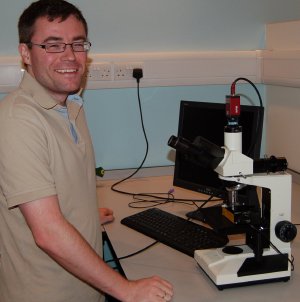Oct 20 2009
NanoSight, manufacturers of unique nanoparticle characterisation technology, has announced that the Centre for Molecular Nanometrology at the University of Strathclyde has selected an LM-10 characterisation system to aid in their research and development of new biosensors.
 Dr Alastair Wark, Lecturer at the University of Strathclyde’s Centre for Molecular Nanometrology and principal user of NanoSight technology for nanoparticle characterisation
Dr Alastair Wark, Lecturer at the University of Strathclyde’s Centre for Molecular Nanometrology and principal user of NanoSight technology for nanoparticle characterisation
Lecturer, Dr Alastair Wark’s research interests are based around the preparation, functionalisation and application of plasmonic nanomaterials. The use of such nanometre-scale materials and tools is opening up exciting new avenues for the investigation of biomolecular interactions and biological systems with unprecedented sensitivity and spatial accuracy.
Other characterisation techniques such as UV-VIS adsorption spectroscopy and DLS (dynamic light scattering) are useful for bulk averaging measurements but it is the ability to visualise individual nanoparticles one at a time that drew former postdoctoral researcher Dr Robert Stokes whilst working with Professor Duncan Graham to select the NanoSight NTA system. This has catalysed the current research being lead by Dr Wark. “The NanoSight provides an intuitive way of sensing particles and being able to work dynamically in biocompatible liquids collecting multiple single sets of particle information gives statistical credibility to the data.”
This initial work is leading into developments for biosensors involving the controlled aggregation of functionalised nanomaterials in the presence of a specific target biomolecule. The ability to monitor this process in solution using particle-by-particle measurements cannot be achieved with bulk characterisation techniques.
NanoSight’s NTA approach has been shown to be ideally suited to such research activities and with the ability to not only look at spherical particles, but also characterise rod-like materials as well makes the system an extremely powerful nanoscale research and development tool.
To learn more about nanoparticle characterisation using NTA, please visit www.nanosight.com and register for the latest issue of NanoTrail, the company’s electronic newsletter.